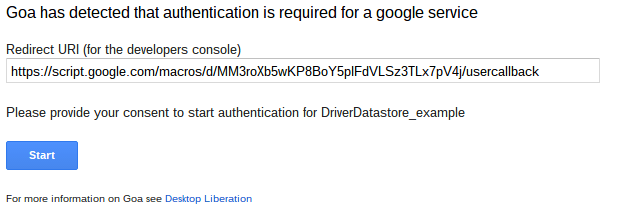This describes how to authenticate with Google Datastore using Goa, as described in Oauth2 for Apps Script in a few lines of code (which you should read first for background).
The library, cGoa, is available under this project key.
MZx5DzNPsYjVyZaR67xXJQai_d-phDA33
Page Content
hide
Setting up
You’ll need to create an App. The dashboard/developers console can be found here. Your one time setup would look something like this.
cGoa.GoaApp.setPackage (propertyStore , {
clientId : "10xxxxxxxx3.apps.googleusercontent.com",
clientSecret : "CxxxxxxxxiBvi",
scopes : cGoa.GoaApp.scopesGoogleExpand (['datastore','userinfo.email']),
service: 'google',
packageName: 'DriverDatastore_example'
});
The example
The example includes 3 functions.
- A doGet example for a web app.
- An example where the token has already been setup by a one off doGet example
- An example of consuming the token
The doGet should be published
function doGet(e) {
return doGetDataStore (e);
}
and will create a consent screen like this, from which the redirect URI can be copied and added to the App dashboard.
The patterns
/**
* this is how to do a webapp which needs authentication
* @param {*} e - parameters passed to doGet
* @return {HtmlOurput} for rendering
*/
function doGetDataStore (e) {
// this is pattern for a WebApp.
// passing the doGet parameters (or anything else)
// will ensure they are preservered during the multiple oauth2 processes
// change this to whatever store & credentials name are being used
var goa = cGoa.GoaApp.createGoa ('DriverDatastore_example',PropertiesService.getScriptProperties()).execute(e);
// it's possible that we need consent - this will cause a consent dialog
if (goa.needsConsent()) {
return goa.getConsent();
}
// if we get here its time for your webapp to run and we should have a token, or thrown an error somewhere
if (!goa.hasToken()) throw 'something went wrong with goa - did you check if consent was needed?';
// This is a webapp doing whaever its supposed to do
// getParams is used to retrieve the original parameters passed to this function
var result = testDataStore (goa.getToken(), goa.getParams() );
// now return it as normal
return HtmlService.createHtmlOutput (result.getContentText())
.setSandboxMode(HtmlService.SandboxMode.IFRAME);
}
function dataStore(params) {
// pick up the token refreshing if necessary
var goa = cGoa.GoaApp.createGoa('DriverDatastore_example', PropertiesService.getScriptProperties()).execute(params);
if (!goa.hasToken()) {
throw 'for a non webapp version - first publish once off to provoke a dialog - token will be refreshed automatically thereafter';
}
// do a test - passing the token and any parameters that arrived to this function
Logger.log (testDataStore (goa.getToken(), goa.getParams() ));
}
/**
* this is your main processing - will be called with your access token
* @param {string} accessToken - the accessToken
* @param {*} params any params
*/
function testDataStore (accessToken,params) {
var options = {
method: "POST",
contentType : "application/json" ,
muteHttpExceptions : true,
headers: {
"authorization": "Bearer " + accessToken,
},
payload:JSON.stringify({
"query": {
"kinds": [{"name":"polymerdbab"}]
}
})
};
return UrlFetchApp.fetch(
"https://www.googleapis.com/datastore/v1beta2/datasets/xliberationdatastore/runQuery", options);
}
For more like this, see OAuth2 for Apps Script in a few lines of code
Why not join our forum, follow the blog or follow me on Twitter to ensure you get updates when they are available.
